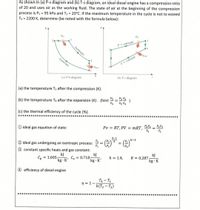
Elements Of Electromagnetics
7th Edition
ISBN: 9780190698614
Author: Sadiku, Matthew N. O.
Publisher: Oxford University Press
expand_more
expand_more
format_list_bulleted
Concept explainers
Question

Transcribed Image Text:As shown in (a) P-v diagram and (b) T-s diagram, an ideal diesel engine has a compression ratio
of 20 and uses air as the working fluid. The state of air at the beginning of the compression
process is P1 = 95 kPa and T1 = 20°C. If the maximum temperature in the cycle is not to exceed
T3 = 2200 K, determine (be noted with the formula below):
9in
Fin
P = constant
Isentropic
Yout
Isentropic
V = constant
(a) P-v diagram
(b) T-s diagram
(a) the temperature T2 after the compression (K).
(b) the temperature T4 after the expansion (K). (hint: 3 = V2
V2 V4
V4
(c) the thermal efficiency of the cycle (%).
************
**********
O ideal gas equation of state:
Pv = RT, PV = mRT,
T2
P2V2
T1
k-1
2 ideal gas undergoing an isentropic process:
%3D
3 constant specific heats and gas constant:
kJ
= 1.005
kg · K'
kJ
Cy = 0.718-
kg · K'
kJ
R = 0.287
Cp =
k = 1.4,
kg · K
4 efficiency of diesel engine
T4 – T1
k(T3 – T2)
n = 1–
***
*******************************************
Expert Solution
This question has been solved!
Explore an expertly crafted, step-by-step solution for a thorough understanding of key concepts.
Step by stepSolved in 3 steps with 3 images

Knowledge Booster
Learn more about
Need a deep-dive on the concept behind this application? Look no further. Learn more about this topic, mechanical-engineering and related others by exploring similar questions and additional content below.Similar questions
- Please do parts A and Barrow_forwardAn ideal diesel cycle powered by air has a compression ratio of 20. At the beginning of the compression process, the pressure of the air is 100 kPa, the temperature is 20°C, and it is desired that the highest temperature of the cycle should not exceed 2250 K. Show the cycle in the P-v diagram. Assume the specific heats are constant at room temperature. k=1.4 CP=1.005kJ/kgK CV=0.718 kJ/kgK R=0.287kJ/kgK a) Calculate the heat entering and leaving the cycle, the thermal efficiency of the cycle, b) Calculate the average effective pressure of the cycle.arrow_forward
Recommended textbooks for you
 Elements Of ElectromagneticsMechanical EngineeringISBN:9780190698614Author:Sadiku, Matthew N. O.Publisher:Oxford University Press
Elements Of ElectromagneticsMechanical EngineeringISBN:9780190698614Author:Sadiku, Matthew N. O.Publisher:Oxford University Press Mechanics of Materials (10th Edition)Mechanical EngineeringISBN:9780134319650Author:Russell C. HibbelerPublisher:PEARSON
Mechanics of Materials (10th Edition)Mechanical EngineeringISBN:9780134319650Author:Russell C. HibbelerPublisher:PEARSON Thermodynamics: An Engineering ApproachMechanical EngineeringISBN:9781259822674Author:Yunus A. Cengel Dr., Michael A. BolesPublisher:McGraw-Hill Education
Thermodynamics: An Engineering ApproachMechanical EngineeringISBN:9781259822674Author:Yunus A. Cengel Dr., Michael A. BolesPublisher:McGraw-Hill Education Control Systems EngineeringMechanical EngineeringISBN:9781118170519Author:Norman S. NisePublisher:WILEY
Control Systems EngineeringMechanical EngineeringISBN:9781118170519Author:Norman S. NisePublisher:WILEY Mechanics of Materials (MindTap Course List)Mechanical EngineeringISBN:9781337093347Author:Barry J. Goodno, James M. GerePublisher:Cengage Learning
Mechanics of Materials (MindTap Course List)Mechanical EngineeringISBN:9781337093347Author:Barry J. Goodno, James M. GerePublisher:Cengage Learning Engineering Mechanics: StaticsMechanical EngineeringISBN:9781118807330Author:James L. Meriam, L. G. Kraige, J. N. BoltonPublisher:WILEY
Engineering Mechanics: StaticsMechanical EngineeringISBN:9781118807330Author:James L. Meriam, L. G. Kraige, J. N. BoltonPublisher:WILEY

Elements Of Electromagnetics
Mechanical Engineering
ISBN:9780190698614
Author:Sadiku, Matthew N. O.
Publisher:Oxford University Press

Mechanics of Materials (10th Edition)
Mechanical Engineering
ISBN:9780134319650
Author:Russell C. Hibbeler
Publisher:PEARSON

Thermodynamics: An Engineering Approach
Mechanical Engineering
ISBN:9781259822674
Author:Yunus A. Cengel Dr., Michael A. Boles
Publisher:McGraw-Hill Education

Control Systems Engineering
Mechanical Engineering
ISBN:9781118170519
Author:Norman S. Nise
Publisher:WILEY

Mechanics of Materials (MindTap Course List)
Mechanical Engineering
ISBN:9781337093347
Author:Barry J. Goodno, James M. Gere
Publisher:Cengage Learning

Engineering Mechanics: Statics
Mechanical Engineering
ISBN:9781118807330
Author:James L. Meriam, L. G. Kraige, J. N. Bolton
Publisher:WILEY